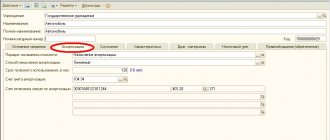Accounting for income taxes on loans and credits is relevant for almost every organization. In accordance with the law, income tax should be reduced by interest paid under loan agreements. But if the company, on the contrary, issued a loan and thereby received a profit in the form of interest, the tax increases.
Features of calculating interest on a loan
Until 2015, an important rule was in force. There was a specially established amount of the “borrowed” interest received, which was to be included in expenses. Now everything has changed a little, and the following rules have come into force:
- There is no fixed amount of accrued interest when determining income tax. The exception is controlled transactions.
- Rationing is used in relation to those loans that, in accordance with the Tax Code of the Russian Federation, were recognized as controlled transactions.
Today, there are several principles for calculating and accounting for interest:
- Accounting, which requires that all interest rates be accounted for separately from the principal amount due.
- Summova. In this case, when calculating income tax, interest is reflected in the amount specified in the agreement. This will be the case unless the loan is recognized as a controlled transaction.
- Settlement. According to this principle, for all loans and credits there is a formula, which should be used to determine the amount of interest that can be included in expenses.
Features for state employees
Budgetary accounting of loans and credits should be kept in a special account 0 207 00 000 “Calculations for loans and borrowings (loans)”. Analytical accounting of borrowed capital should be kept in the card for recording loans issued. Unified document form - f. 0504057.
Provide analytics for:
- types of borrowings;
- categories of creditors;
- amounts of principal, accrued and paid interest, as well as additional costs for servicing loans.
Register account transactions regarding the receipt of loans and transfers of amounts for repayment in the journal of transactions for non-cash payments (f. 0504071). Record the accrual of interest, as well as penalties and fines on the loan in the journal for other transactions (clause 211 of Instruction No. 157n).
Controlled interest
The features of tax regulation by percentage include:
- Two-way action. It must be remembered that both the borrower's interest expenses and the lender's interest income are subject to rationing.
- Safe betting intervals. Any interest earned at such intervals must be fully tax included. Such intervals are indicated in clause 1.2 of Art. 269 of the Tax Code of the Russian Federation. Starting from 2021, all interest on ruble loans from controlled transactions is calculated the same way - at 75-125% of the Central Bank rate.
The interval rule has a number of features:
- If the rate is greater than the minimum of the interval, then interest income is calculated at the actual rate.
- If the rate is less than the maximum, then the expense is calculated at the actual rate.
- If the rate is outside the interval, pricing methods are applied.
Since 2021, there have been more cases where debt is considered manageable. The following have been added to all previously existing cases:
- If the company's share of participation is more than 25%.
- If the participation of a foreign company in the taxpayer goes through some other organizations, but provided that the share of participation in those organizations is more than 50%.
In order for interest on a loan to be recognized as uncontrollable, you must:
- Compare the loan amount with the organization’s own capital.
- Calculate maximum interest rates using the capitalization ratio.
- If there is no excess, then apply the actual rate.
Transactions are considered controlled in the following cases:
- If an interdependent person participated in the transaction and if the annual income from such transactions exceeded 1 billion rubles.
- If the transaction involved an interdependent person working under the simplified tax system and if the income exceeded 60 million rubles per year.
- If the interdependent person participating in the transaction works under the unified agricultural tax or under the UTII and the annual income was more than 100 million.
- Any transactions with offshore companies with an annual income of 60 million.
A transaction cannot be uncontrolled in the following cases:
- If both parties to the transaction are Russian companies (and not banks), guarantees were provided.
- If both parties to the transaction are registered or reside in the Russian Federation.
If, according to some parameters, it turns out that the transaction is controlled, the taxpayer is obliged to check the compliance of the applied market rate.
The Department clarifies the procedure for accounting for interest on loans when calculating income taxes
Date of publication: 04/18/2016 13:10 (archive)
Based on paragraph 6 of Article 250 of the Tax Code of the Russian Federation, income in the form of interest received under loan agreements, credit agreements, and other debt obligations is recognized as non-operating income of the taxpayer.
Non-operating expenses not related to production and sales include, in particular, expenses in the form of interest on debt obligations of any type.
The amount of income (expense) in the form of interest on debt obligations is taken into account by the taxpayer in tax accounting based on the profitability established for each type of debt obligation and the validity period of such debt obligation as of the last date of the reporting (tax) period.
The specifics of accounting for interest on debt obligations for the purpose of taxing the profits of organizations are established in Article 269 of the Tax Code of the Russian Federation.
Starting from January 1, 2015, recognition of expenses in the form of interest on debt obligations is carried out based on the actual rate established by the loan agreement. That is, from January 1, 2015, the rationing of expenses in the form of interest on debt obligations was abolished. The exception is cases of recognition of interest on debt obligations arising as a result of transactions recognized in accordance with the provisions of the Tax Code of the Russian Federation as controlled transactions.
From January 1, 2015, for debt obligations of any type arising as a result of transactions recognized as controlled transactions in accordance with the Tax Code of the Russian Federation, interest is recognized as income (expense) calculated based on the actual rate, taking into account the provisions of Section V.1 of the Tax Code of the Russian Federation, if otherwise is not established by Article 269 of the Tax Code of the Russian Federation.
For a debt obligation arising as a result of a transaction, the taxpayer has the right to recognize as income (expense) interest calculated on the basis of the actual rate on such debt obligations, within the established intervals of the maximum interest rates on debt obligations.
If the conditions are not met, for debt obligations arising as a result of transactions, interest calculated on the basis of the actual rate taking into account the provisions of Section V.1 of the Tax Code of the Russian Federation is recognized as income (expense).
The provisions of Article 269 of the Tax Code of the Russian Federation apply to interest accrued from January 1, 2015 on contracts concluded both before January 1, 2015 and after this date.
Explanations are given in letters from the Ministry of Finance of Russia: dated July 6, 2015 No. 03-03-06/1/38933, dated July 15, 2015 No. 03-01-18/40737, dated February 20, 2016 No. 03-03-06/1/9825.
Rationing of interest
If a company received a loan from its employee or any other individual, then the interest rates must be specified in the agreement. They are payment for the use of the borrowed amount. In such cases, companies can include all interest in tax amounts, there are no restrictions on this for uncontrolled transactions.
At the same time, the borrower is required to charge and withhold income tax. The borrower must transfer all interest to the lender minus personal income tax. The borrower makes payments to the budget within the time limits specified in the Tax Code. The borrower must indicate all interest income and taxes paid on it in reports and in the tax register.
If it is agreed that an individual will receive interest not in money, then personal income tax will be charged on all income paid by the borrowing company. If the borrower has no way to withhold personal income tax, then he must notify the tax authority and his lender about this.
If a loan was taken out to purchase an investment asset, then all interest on the loan is included in the item non-operating expenses. There is no difference whether it is a regular asset or an investment one. The price of an investment asset tends to increase by the amount of interest (but provided that borrowed funds were used to create the asset).
Important! If borrowed funds were used to pay dividends, interest may also be included as an expense.
PBU 15/2008
6. Loan expenses are reflected in accounting and reporting in the reporting period to which they relate.
7. Loan expenses are recognized as other expenses, with the exception of that part of them that is subject to inclusion in the cost of the investment asset, unless otherwise established by this paragraph (paragraph supplemented starting from the annual financial statements for 2010 by Order of the Ministry of Finance of Russia dated November 8, 2010 No. 144n - see previous edition).
The cost of an investment asset includes interest payable to the lender (creditor) directly related to the acquisition, construction and (or) production of the investment asset.
For the purposes of these Regulations, an investment asset is understood as an object of property, the preparation of which for its intended use requires a long time and significant expenses for acquisition, construction and (or) production. Investment assets include objects of work in progress and construction in progress, which will subsequently be accepted for accounting by the borrower and (or) customer (investor, buyer) as fixed assets (including land), intangible assets or other non-current assets.
Organizations that have the right to use simplified accounting methods, including simplified accounting (financial) reporting, can recognize all borrowing costs as other expenses.
(The paragraph was additionally included starting from the annual financial statements for 2010 by Order of the Ministry of Finance of Russia dated November 8, 2010 No. 144n; as amended, put into effect starting from the annual financial statements for 2012 by Order of the Ministry of Finance of Russia dated April 27, 2012 No. 55n; as amended , put into effect on May 17, 2015 by Order of the Ministry of Finance of Russia dated April 6, 2015 No. 57n - See previous edition.)
8. Interest payable to the lender (creditor) is included in the cost of the investment asset or other expenses evenly, as a rule, regardless of the terms of the loan (credit). Interest payable to the lender (creditor) may be included in the cost of the investment asset or as part of other expenses based on the terms of the loan (credit) in the case where such inclusion does not differ significantly from equal inclusion.
Additional borrowing costs may be included evenly as part of other expenses during the term of the loan (loan agreement).
9. Interest payable to the lender (creditor) is included in the cost of the investment asset if the following conditions are met:
a) expenses for the acquisition, construction and (or) production of an investment asset are subject to recognition in accounting;
b) borrowing costs associated with the acquisition, construction and (or) production of an investment asset are subject to recognition in accounting;
c) work has begun on the acquisition, construction and (or) production of an investment asset.
10. Interest payable to the lender (creditor) associated with the acquisition, construction and (or) production of an investment asset is reduced by the amount of income from the temporary use of funds received from loans (credits) as long-term and (or) short-term financial investments.
11. When the acquisition, construction and (or) production of an investment asset is suspended for a long period (more than three months), interest payable to the lender (creditor) ceases to be included in the cost of the investment asset from the first day of the month following the month of suspension of the acquisition, construction and/or manufacturing of such an asset.
During the specified period, interest payable to the lender (creditor) is included in other expenses of the organization.
When renewing the acquisition, construction and (or) production of an investment asset, interest payable to the lender (creditor) is included in the cost of the investment asset from the first day of the month following the month of resumption of acquisition, construction and (or) production of such an asset.
The period during which additional approval of technical and (or) organizational issues that arose in the process of acquisition, construction and (or) production of an investment asset is not considered a period of suspension of the acquisition, construction and (or) production of an investment asset.
12. Interest payable to the lender (creditor) ceases to be included in the cost of the investment asset from the first day of the month following the month of termination of the acquisition, construction and (or) production of the investment asset.
13. If an organization begins to use an investment asset for the manufacture of products, performance of work, provision of services despite the incompleteness of work on the acquisition, construction and (or) production of the investment asset, then the interest payable to the lender (creditor) ceases to be included in the cost of such an asset from the first day of the month following the month in which the investment asset began to be used.
14. If funds from loans (credits) received for purposes not related to such acquisition, construction and (or) production are spent on the acquisition, construction and (or) production of an investment asset, then the interest payable to the lender (creditor) ), are included in the cost of the investment asset in proportion to the share of these funds in the total amount of loans (credits) payable to the lender (creditor), received for purposes not related to the acquisition, construction and (or) production of such an asset.
"Natural" interest
Interest can be paid not only in monetary terms. The loan can be issued in kind and any material assets can be used for payments - goods, products, etc. Even if such a loan has been issued, the agreement must still indicate the method of payment of interest. The terms for paying interest rates for a loan in kind are the same as for conventional loans.
Calculation of interest to the lender using the simplified tax system
If an individual who is a founder wants to take out an interest-bearing loan from a company operating under the simplified tax system, then the following rules apply:
- The agreement specifies the rules for paying interest. If there are no interest conditions, then the borrower undertakes to pay them every month until the debt is paid in full.
- It is very convenient for everyone working under the simplified tax system to pay the entire amount of interest. This is because all interest income must be recorded for the tax authority. This is done on the date when they actually arrive at the company’s cash desk or into its current account. For accounting, this does not play an important role, since in accounting the accrual of interest along with income should be displayed every month.
- Personal income tax is also paid on the material benefit from savings on interest. This only applies to cases where the contract rate is less than 2/3 of the Central Bank refinancing rate. Such calculations must be performed on the last day of the month throughout the entire period of use of borrowed funds.
Accounting for interest on non-fulfillment or delay in fulfilling a monetary obligation
In accordance with paragraph 1 of Article 811 of the Civil Code of the Russian Federation, in cases where the borrower does not repay the loan amount on time, interest is payable on this amount in the manner and amount provided for in paragraph 1 of Article 395 of the Civil Code of the Russian Federation, from the day on which it should have been repaid, until the day of its return to the lender, regardless of the payment of interest provided for in Article 809 of the Civil Code of the Russian Federation.
The interest provided for in paragraph 1 of Article 395 of the Civil Code of the Russian Federation for non-fulfillment or delay in fulfilling a monetary obligation is payable only on the corresponding amount of funds and should not be accrued on interest for the use of someone else’s funds. This is evidenced by paragraph 51 of the Resolution of the Plenum of the Supreme Court of the Russian Federation No. 6, the Plenum of the Supreme Arbitration Court of the Russian Federation No. 8 of July 1, 1996 “On some issues related to the application of part one of the Civil Code of the Russian Federation.”
In addition, interest for non-fulfillment or delay in fulfilling a monetary obligation is repaid after the amount of the principal debt. This is evidenced by paragraphs 4, 11, 15 of Resolution No. 13/14.
The amount of interest is determined by the bank interest rate existing at the location of the lender (the refinancing rate of the Central Bank of the Russian Federation) on the day of fulfillment of the monetary obligation, that is, on the day the borrower repays the obligations.
Interest accrued by an organization in accordance with paragraph 1 of Article 395 of the Civil Code of the Russian Federation for the use of its funds is also recognized as non-operating income of the organization and is reflected in the credit of account 91, subaccount 91-1, and the debit of account 76 “Settlements with various debtors and creditors.”
Let us assume that on the specified date (June 25 of the current year) the refinancing rate of the Central Bank of the Russian Federation is in effect, set at 14% per annum.
The amount of interest accrued in accordance with civil law for the period from June 1 to June 25 is:
100,000 rubles x 14% / 365 days. X 25 days = 959 rubles.
Tax obligations when providing a loan
Any loan agreement is an agreement between the parties that the borrower is provided with money or any valuable property, and he undertakes to repay the debt on time. When concluding such agreements without interest charges, the following tax obligations arise:
- VAT. Here, the form in which the loan was issued is of great importance. There is no need to pay VAT if the loan was issued in cash. This is due to the fact that in this case there is no transfer of ownership. You don't even need to create an invoice here. If the loan was provided in the form of an item, then VAT exemption is not provided. The lender must send the client an invoice with allocated VAT within 5 days from the moment of transfer of things. Thus, it turns out that when issuing a loan not in cash, VAT is calculated already at the time of transfer of property.
- Income tax. Any property transferred under a loan agreement cannot be included as an expense when taxing profits.
- Insurance premiums. There are no insurance premiums for loans. This equally applies to pension, medical and social insurance contributions, as well as those that are listed as contributions for injuries.
Interest-bearing loans have the following differences:
- They are not subject to VAT.
- Interest on the loan goes to the item “non-operating income”.
- Personal income tax is paid if an individual receives benefits by saving on interest.
- Insurance premiums are not paid in this case either.






